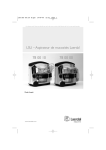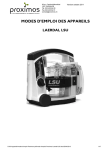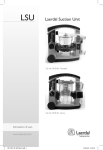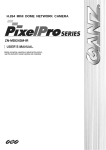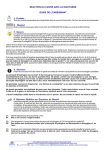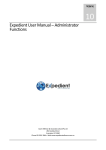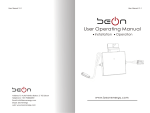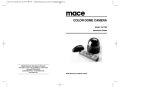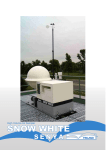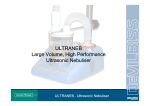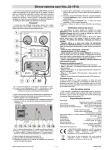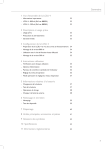Download Laerdal Suction Unit User Manual
Transcript
LSU DfU 8179rev B.qxd 8/12/05 11:24 AM Side 1 Laerdal Suction Unit 78 00 10 Directions for Use www.laerdal.com 78 00 00 LSU DfU 8179rev B.qxd 8/12/05 11:24 AM Side 2 1 Cautions and Warnings Read these Directions for Use carefully, and become thoroughly familiar with the operation and maintenance of the LSU before using it. The LSU should only be used by persons trained in the use of medical suction equipment. The LSU is not suitable for use in the presence of flammable liquids or gases; there can be a danger of explosion or fire. Do not use the LSU under environmental conditions that are outside the ranges specified under section 11.6.This can endanger safety and adversely affect operation of the device. Do not immerse the LSU or allow it to stand in water or other liquids.This might damage the device, and cause electrical hazard. Do not pump any cleaning solution or other liquids through the vacuum pump, i.e. through the Vacuum Connector.This can damage the LSU. Use only accessories supplied by Laerdal or one of our authorised distributors to ensure that the LSU operates satisfactorily. Battery: - To maintain satisfactory operation of the battery, it is recommended to place the LSU on continuous charge when not in use. - The LSU must be placed on charge for a minimum of 24 hours to reach full battery capacity.The fast charging gives approximately 80% battery capacity after 3 hours (for a new battery). Please note that repetitive 3 hour charging is not recommended. - If it is not possible to place the LSU on continuous charge when not in use, make sure the battery is charged for a minimum of 24 hours at least once a month. - Do not store the battery when it is discharged; always fully charge the battery before storage. Do not block the Exhaust Outlet during use.This will lead to reduced flow and can also cause damage to the LSU. Do not use the Reusable version without a filter or the Float Ball. Use only the disposable Abbott liner with filter. If overflow of liquid from the Canister into the pump is suspected, the LSU must be returned for service (see section 9). Overflow of suctioned material can damage the device. Disconnect the LSU from external power prior to cleaning. Use a minimum of liquid to prevent any electrical shock hazard. 2 8/12/05 11:24 AM Side 3 Contents 1 2 2.1 2.2 2.3 2.4 2.5 3 3.1 3.2 3.3 3.4 3.5 4 4.1 4.2 4.3 4.4 5 5.1 5.2 5.3 5.4 6 6.1 6.2 6.3 6.4 6.5 6.6 6.7 6.8 6.9 7 7.1 7.2 7.3 8 9 10 11 Cautions and Warnings . . . . . . . . . . . . . . . .2 Introduction . . . . . . . . . . . . . . . . . . . . . . . . .4 Unpacking and prepare the LSU for use . . . . . . . . . . . . . . . . . . . . . 4 Indications for Use . . . . . . . . . . . . . . . . . . 4 Contraindications . . . . . . . . . . . . . . . . . . . 4 Features and Benefits . . . . . . . . . . . . . . . . 4 Limited Warranty . . . . . . . . . . . . . . . . . . . 4 Description . . . . . . . . . . . . . . . . . . . . . . . . 5 Quick Reference Guide . . . . . . . . . . . . . . 5 User Interface . . . . . . . . . . . . . . . . . . . . . . 6 Canister Systems . . . . . . . . . . . . . . . . . . . . 8 Power Sources . . . . . . . . . . . . . . . . . . . . . . 9 Automatic Power-save Function . . . . . . . . 9 Operation LSU with Reusable Canister . . . . . . . . . . . . . . 10 Getting Started . . . . . . . . . . . . . . . . . . . . .10 Emptying the Canister . . . . . . . . . . . . . . .10 Assembly of the Reusable Canister System . . . . . . . . . . . . . . . . . . . . .11 After Use . . . . . . . . . . . . . . . . . . . . . . . . . . 12 Operation LSU with Disposable Canister. . . . . . . . . . . . . 13 Getting Started . . . . . . . . . . . . . . . . . . . . 13 Replace the Disposable Canister . . . . . . 13 Assembly of the Disposable Canister System . . . . . . . . . . . . . . . . . . . . 14 After Use . . . . . . . . . . . . . . . . . . . . . . . . . . 15 Maintenance . . . . . . . . . . . . . . . . . . . . . . . 15 General . . . . . . . . . . . . . . . . . . . . . . . . . . .15 Battery . . . . . . . . . . . . . . . . . . . . . . . . . . . .15 Cleaning the Cabinet . . . . . . . . . . . . . . . .15 Decontamination of Reusable Parts . . . .16 Charge the Battery . . . . . . . . . . . . . . . . . 17 Check the Battery Quality . . . . . . . . . . . 17 Replace the Battery . . . . . . . . . . . . . . . . . 18 Fastening brackets . . . . . . . . . . . . . . . . . . 18 Release arm for Canister holder . . . . . . 18 Device Test . . . . . . . . . . . . . . . . . . . . . . . . 18 Setup . . . . . . . . . . . . . . . . . . . . . . . . . . . . . 18 Run the test . . . . . . . . . . . . . . . . . . . . . . . 18 Evaluation of Device test Results . . . . . . 20 Accessories and Parts . . . . . . . . . . . . . . . 21 Servicing . . . . . . . . . . . . . . . . . . . . . . . . . . 22 Trouble Shooting . . . . . . . . . . . . . . . . . . . 22 Specifications . . . . . . . . . . . . . . . . . . . . . . 23 11.1 11.2 11.3 11.4 11.5 11.6 11.7 11.8 11.9 12 3 Classification . . . . . . . . . . . . . . . . . . . . . . . General tolerance . . . . . . . . . . . . . . . . . . Physical Characteristics . . . . . . . . . . . . . . Operation . . . . . . . . . . . . . . . . . . . . . . . . . Power Requirements . . . . . . . . . . . . . . . . Environmental Conditions . . . . . . . . . . . Material Chart . . . . . . . . . . . . . . . . . . . . . Symbols . . . . . . . . . . . . . . . . . . . . . . . . . . . EMC Specifications . . . . . . . . . . . . . . . . . Addresses . . . . . . . . . . . . . . . . . . . . . . . . . 23 23 23 23 24 24 24 24 25 27 ENGLISH LSU DfU 8179rev B.qxd LSU DfU 8179rev B.qxd 8/12/05 11:24 AM Side 4 2 Introduction 2.1 Unpacking and prepare the LSU for use - Remove the LSU from its packaging and inspect all parts for damage. If there are any signs of damage or if any parts are missing, immediately notify Laerdal or one of our authorised distributors. - Insert the battery according to section 6.7. - Place the LSU on charge for a minimum of 24 hours to make sure you have a fully charged battery (see section 6.5). - After being charged for 24 hours, perform the Device Test according to section 7. 2.5 Limited Warranty The LSU comes with a five (5) year limited warranty*. See the enclosed “Laerdal Global Warranty” for terms and conditions. The warranty is also available at www.laerdal.com * Excluding the canister and tubing systems. 2.2 Indications for Use The LSU is a portable, electrically powered, medical suction equipment intended for field and transport use. It is intended for intermittent operation to remove secretions, blood or vomit from a patient´s airway to allow ventilation. Higher vacuum levels are generally selected for oropharyngeal suctioning, and lower vacuum levels are usually selected for tracheal suctioning and the suctioning of children and infants. 2.3 Contraindications None known. 2.4 Features and Benefits - Splashproof, rugged and solid. - Easy access to the tubing. - Equipped with an internal battery that can easily be replaced without using tools. - Charging of battery can be done directly from AC or DC mains - no external charger is needed. - Fast charge option of 3 hours, giving approx. 80% battery capacity. - Operation possible from internal battery and directly from AC or DC mains - no adapter is needed. - A large combined ON/OFF switch and vacuum selector makes operation easy even with heavy-duty gloves. - A green LED bargraph makes it easy to observe the actual vacuum level during operation. - Another green LED bargraph indicates approx. remaining battery capacity. 4 8/12/05 11:24 AM Side 5 ENGLISH LSU DfU 8179rev B.qxd 3 Description 3.1 Quick Reference Guide 3.1.1 LSU w/Reusable Canister System Aerosol Filter PATIENT Inlet Vacuum Connector Patient Suction Tubing VACUUM Inlet Suction Catheter Adapter User Interface Holder for Water Bottle/Patient Suction Tubing. Canister Water Bottle Canister Lid with Float Ball Battery Door Canister Holder Release Arm 3.1.2 LSU w/Disposable Canister System PATIENT Inlet Vacuum Connector Patient Suction Tubing VACUUM Inlet User Interface Vacuum tubing Canister Abbott liner with filter Canister Holder T-bar Release Arm Battery Door 5 LSU DfU 8179rev B.qxd 8/12/05 11:24 AM Side 6 TEST-Button Vacuum Indicator Power ON Indicator Battery Status Indicator External Power Indicator Failure Mode Indicator Operating Knob 3.2 User Interface - It flashes slowly (approx. once per second) while the Automatic Power-save Function is activated, if the Device Test is interrupted or when the battery is discharged. 3.2.1 Operating Knob The Operating Knob is a combined ON/OFF switch and vacuum selector, located at the bottom of the User Interface. The LSU is switched ON by turning the Operating Knob to the required setting. Each setting indicates the maximum achievable vacuum level for the selected position (80, 120, 200, 350, 500+ mmHg).The free air flow value changes along with the increasing vacuum settings (see section 11.4 for details).The LSU is switched OFF by resetting the Operating Knob to "0". Even if the Operating Knob is in “0” position, voltage is present on some of the internal circuitry, when the LSU is connected to mains.To fully remove power, pull out the Power Cord. 3.2.2.2 External Power Indicator This green LED is continuously lit while external AC or DC power is connected. 3.2.2.3 Failure Mode Indicator The red LED is lit when a possible malfunction of the LSU has been detected. If lit, turn the LSU OFF, and then ON again to check if the indication disappears. Provided that the indication does not occur again the LSU can be operated. If the Indicator continues to lit after three OFF/ON cycles and after replacing the battery with a fully charged battery, discontinue use and return the LSU for service. (See section 9). 3.2.2 Indicators 3.2.2.1 Power ON Indicator This green LED has 3 modes: - It is lit continuously while the LSU is switched ON. - It flashes rapidly (approx. twice per second) during the Device Test. 6 8/12/05 11:24 AM Side 7 CAPACITY for a new battery stored in room temperature > 75 % 50 - 75% 25 - 50% < 25% Battery Low; (min. 2 minutes of operation left based on 500+ mmHg/free flow). 3.2.2.4 Vacuum Indicator This green LED bargraph displays the actual vacuum level during operation of the LSU. Each fully lit segment represents 50 mmHg. If a segment has a weak light, this represents 25 mmHg (e.g 125 mmHg means 2 fully lit and 1 weakly lit segments). OUTPUT 4 LEDs lit. 3 LEDs lit. 2 LEDs lit. 1 LED lit. 1 LED flashes. During charging: indicates approx. achieved battery capacity. mmHg kPa mBar 80 11 107 120 16 160 200 27 267 350 47 467 CAPACITY < 75% 500 67 667 75 - 80% > 80% 3.2.2.5 Battery Status Indicator This green LED bargraph has 3 functions: - Indicates remaining battery capacity during operation from internal battery - Indicates approx. achieved battery capacity during charging - Indicates which test is currently in progress during device test OUTPUT* The LED's will be lit sequentially. 3 LED's lit and 4th flashing. 4 LED's lit. *Note: If no battery is installed, the battery status indicator will be fully lit for approx. 5 sec. until it is turned off. During the Device Test: indicates which step of the test is currently in progress or which corresponding test result is being displayed: LED 1 (lower LED) lit = STEP 1, LED 2 lit = STEP 2 etc. During operation from internal battery: - indicates approx. remaining battery capacity. During operation from internal battery and during charging the displayed values must only be used as indications. Several parameters can influence them e.g. device settings, state of battery, temperature etc. 3.2.3 TEST-Button This button allows you to run a 4-step user initiated Device Test program to identify whether the LSU is operating satisfactorily or if it needs service (see section 7). Note: Immediately after turning the LSU ON and immediately after switching from external power to internal battery operation, all 4 LED's will flash for 5 seconds before the remaining battery capacity is displayed. 7 ENGLISH LSU DfU 8179rev B.qxd LSU DfU 8179rev B.qxd 8/12/05 11:24 AM Side 8 3.3 Canister Systems The LSU can be delivered with a Reusable or a Disposable Canister System as described below. Both Canisters have a corresponding sized Canister Holder. 3.3.1 LSU Reusable Canister System Patient Suction Tubing Canister PATIENT Inlet VACUUM Inlet. Canister Lid w/Float Ball Gasket Angled Connector Suction Catheter Adapter Vacuum seal The LSU Reusable Canister System consists of: - A 1000 ml transparent plastic Canister. - A Canister Lid w/Float Ball that prevents overflow if the Canister is full or the LSU tips over. - An Aerosol Filter with tubing that protects the LSU by preventing aerosols from entering the Pump Unit.* The Canister Lid contains a Float Ball that shuts off the vacuum if the canister is full or the LSU tips over.To reset the valve, remove the Angled Connector from the VACUUM Inlet. The LSU Reusable Canister System must not be used without the Aerosol Filter or the Float Ball. It is recommended always to have extra Aerosol Filters with the LSU in case one has to be discarded. Aerosol Filter Decontamination must be performed in accordance with section 6.4. For the Aerosol Filter the instructions below must be followed: - The Aerosol Filter is not designed for decontamination. - It is recommended that the Aerosol Filter be replaced after each use or at least once every shift. If the LSU is used on patients or in areas where cross contamination is not an issue, the Aerosol Filter should be replaced at least once a month. - If the Aerosol Filter becomes wet, it should be replaced immediately or as soon as possible after use. *The Aersol Filter is not intended for microbiological or for particle filtration. 8 8/12/05 11:24 AM Side 9 ENGLISH LSU DfU 8179rev B.qxd 3.3.2 Disposable Canister System Disposable Parts Reusable Parts PATIENT Inlet Patient Suction Tubing Reusable Canister T-bar Vacuum Connector Tubing VACUUM Inlet Disposable Liner including lid with filter, tube and connectors The Disposable Canister System consists of: - A 1000 ml reusable transparent plastic Canister including a Canister Connector. - A disposable liner including lid with filter, tube and connectors. The Abbott Receptal® Canister contains a hydrophilic filter that shuts off the vacuum if the canister is full or the LSU tips over.To restore the vacuum, replace the inner liner. A Wall Bracket to hold the LSU during operation and (optional) charging is available separately (see section 8). Note: Do not use an Abbott liner without a filter! External power connection will cause the External Power Indicator to be lit. Always check that it is lit when connecting external power or inserting the LSU into the Wall Bracket. AC Connector Socket DC Connector Socket The disposable parts must be replaced after each use.The Reusable Canister must be cleaned as stated on the canister.The Vacuum Connector Tubing is reusable and should be cleaned in accordance with section 6.3. 3.5 Automatic Power-save Function The LSU has an Automatic Power-save Function that switches the pump motor off. While in this mode, the Power ON Indicator will flash slowly (approx. once per second). This function will be activated when the Operating Knob is set to 200, 350 or 500+ mmHg and the actual vacuum level has been continuously higher than 120 mmHg for more than 2 minutes. To exit the Power-save Mode and revert to normal operation, set the Operating Knob to any other position and then go back to required setting. A Filter Tubing is available for the Abbott Canister System (see section 8). 3.4 Power Sources The LSU is delivered with an AC Power Cord for connection to AC mains and a DC Power Cord for connection to DC mains. The device can be operated from the internal battery, and can be operated or charged from one of the following external Power Sources: - AC mains when used with the AC Power Cord: 100-240 VAC (50/60/400 Hz). - DC mains when used with the DC Power Cord: 12-28 VDC. 9 LSU DfU 8179rev B.qxd 8/12/05 11:24 AM 4. Operating LSU with Reusable Canister Note: Read all the Cautions and Warnings listed in section 1 thoroughly before you use the LSU. The parts are color coded to help re-assembly after cleaning. Side 10 5. Set the Operating Knob to the required vacuum level.The LSU will automatically be switched ON and start to operate. The green Power ON Indicator is lit continuously while the LSU is switched ON. 6. When suction is complete, set the Operating Knob to "0" 4.1 Getting Started 1. Check that no parts are missing and that all parts are clean. 2. If you decide to operate the LSU from external power, connect to either external AC or DC power as described in section 3.4. If you decide to operate the LSU from internal battery, check that the battery is installed. 3. Ensure that the Patient Suction Tubing is securely connected to the PATIENT Inlet on the Canister Lid; and the Aerosol filter is securely fastened in the LSU and the lid. Note: To prevent overflow, the LSU must be transported in an upright position when the canister contains suctioned material. 4.2 Emptying the Canister Note: To prevent damage and keep the LSU in good working order; empty the canister when 3/4 full. Check the filter after each use. If the filter is broken so liquid penetrates the membrane, the pump will be contaminated, and the LSU must be returned for service (see section 9). When liquid reaches the top of the Canister, the LSU will stop suctioning.To continue suctioning, empty canister and replace the filter. Over flow of suctioned material can damage the device. To remove the Canister, proceed as follows: 4 Unwrap the Patient Suction Tubing. Note: The LSU must be operated in the upright position to prevent overflow of suctioned material. 1. Disconnect the Filter Tubing from the blue Vacuum Inlet (see section 3.3.1 regarding handling instructions for the Aerosol Filter). 10 8/12/05 11:24 AM Side 11 ENGLISH LSU DfU 8179rev B.qxd 3. Secure the Lid to the Canister by turning it clockwise until it is securely fastened. 2. To release the Canister Holder, press down the Release Arm while sliding the Holder towards you. Remove the Canister from the Holder. 4. Connect the Suction Catheter Adapter to the Patient Tube. 3. Release the Patient Suction Tubing (if applicable). 4. Safely dispose of the contents of the Canister according to local protocols. 5. Clean the LSU according to section 6.3 and its reusable parts according to section 6.4. 5. Connect the Angled Connector to the Patient Tube. 4.3 Assembly of the Reusable Canister System 1. Place the yellow Gasket in the Lid, make sure that the gasket is placed flat in the Lid and not twisted. 6. Mount the yellow Vacuum Seal in the centre hole of the Lid and push it into place. 2. If the Float Ball has been removed, hold the lid upside down and snap the ball into place as shown. 7. Connect the Aerosol Filter (blue ring) to the blue Vacuum Inlet on the LSU. (Color code: Blue on Blue) Note: Never use the LSU without the Float Ball. 11 LSU DfU 8179rev B.qxd 8/12/05 11:25 AM Side 12 8. Insert the Canister in the canister holder and slide it into the LSU. 4.3.1 Reusable Canister System Quick reference The assembly of the tubing is illustrated on the right side of the LSU. 1. Connect the blue Aerosol filter to the blue Vacuum Inlet. 2. Connect the yellow angled connector to the yellow Vacuum Seal. 3. Connect the Patient Tubing to the Patient inlet. 9. Connect the yellow Angled Connector to the yellow Vacuum Seal (Color code:Yellow on Yellow) 4.4 After Use - When suction is complete, set Operating Knob to ”0” and inspect all parts for damage or excessive wear. Replace parts if necessary. - Clean the LSU according to section 6.3 and its reusable parts according to section 6.4. - Perform the Device Test according to section 7. - Place the LSU on charge (see section 6.5). 10. Connect the Angled Connector on the Patient tubing to the PATIENT Inlet on the canister Lid. 11. Perform the Device Test according to section 7 12. Wind the Patient Tubing on the Patient Tubing Holder 13. Place the LSU on charge (see section 6.5) Note: Connect tubing according to color code: Blue on Blue & Yellow on Yellow. 12 8/12/05 11:25 AM 5. Operating LSU with Disposable Canister Side 13 8. When suctioning is complete, set the Operating Knob to "0" 5.1 Getting Started Note: Read all the Cautions and Warnings listed in section 1 thoroughly before you use the LSU. Note: To prevent overflow the LSU should be transported in an upright position when the canister contains suctioned material. 1. Check that no parts are missing and that all parts are clean. 2. If you decide to operate the LSU from external power, connect to either external AC or DC power as described in section 3.4. If you decide to operate the LSU from internal battery, check that battery is installed. 3. Ensure that the T-bar is securely tightened and the yellow connector from the Abbott liner goes to the yellow T-bar on the canister. (Yellow on Yellow). 4. Connect the blue Vacuum Tubing connector to the blue Vacuum Inlet on the LSU. (Blue on Blue). Connect the yellow connector to the yellow T-bar (Yellow on Yellow). 5. Ensure that the Patient Suction Tubing is securely connected to the PATIENT Inlet on the Canister Lid. 5.2 Replace the Disposable Canister Note: It is recommended to replace the Canister when it is 3/4 full. When liquid reaches the top of the Canister, the LSU will not suction any more liquid. If over flow of liquid from the Canister into the pump is suspected, the LSU must be returned for service (see section 9). Over flow of suctioned material can damage the device. To remove the Canister, proceed as follows: 1. Disconnect the Vacuum Connector Tubing at the yellow T-bar on the canister Connector. 6 Release the Strap holding the Patient Suction Tubing. 2. Release the Canister Holder, press down the Release Arm while sliding the Holder towards you. 3. Remove the Canister from the Holder. Note: The LSU should be operated in the upright position to prevent overflow of suctioned material. 7. Set the Operating Knob to the required vacuum level, and the LSU will automatically be switched ON and start to operate. The green Power ON Indicator is lit continuously while the LSU is switched ON. 4. Unwrap/release the Patient Suction Tubing (if applicable). 13 ENGLISH LSU DfU 8179rev B.qxd LSU DfU 8179rev B.qxd 8/12/05 11:25 AM Side 14 4. Insert the Canister in the in the Canister Holder and slide it into the LSU. 5. Safely dispose of the Abbott Liner according to local protocols. 6. Clean the LSU according to section 6.3. 5. Connect the yellow Connector on the Vacuum tubing to the Yellow T-Bar on the Abbott Canister (Color code:Yellow on Yellow). 5.3 Assembly of the disposable canister system 6. Connect the white Angled Connector to the Patient Tubing 1. Mount the Disposable Abbott Liner in the Abbott Canister 7. Connect the white Angled Connector to the white PATIENT INLET on the Abbott Liner (Color code: White on White) 8. Perform the Device Test according to section 7 2. Make sure that the yellow T-bar is securely tightened. Connect the yellow connector from the Abbott Liner to the yellow T-Bar on the Abbott Canister. (Color code:Yellow on Yellow). 9. Strap the Patient Tubing to the side of the LSU. 10. Place the LSU on charge (see section 6.5) 3. Connect the blue Vacuum Connector on the Vacuum Tubing to the blue Vacuum Inlet on the LSU. (Color Code: Blue on Blue). Note: Connect tubing to color code: Blue on Blue, Yellow on Yellow & White on White. 14 8/12/05 11:25 AM Side 15 6. Maintenance 6.1 General - Make sure the maintenance instructions under section 4.4 and 5.4 are followed. - If the device is not in frequent use (i.e. less than once a month), the Device Test (see section 7) should be performed both on a monthly basis and after each use. 6.2 Battery - To maintain satisfactory operation of the battery, it is recommended to place the LSU on continuous charge when not in use. - Replace the battery when it does not pass the Battery Quality Check (see section 6.6 for details), or after 3 years. - Do not store the LSU with an empty battery. 5.3.1 Disposable Canister System Quick reference The assembly of the tubing is illustrated on the right side of the LSU. 1. Connect the blue Vacuum Connector on the Vacuum Tubing to the blue Vacuum Inlet. 2. Connect the two yellow connectors to the yellow T-bar on the Abbott canister. 3. Connect the white Patient Tubing to the white Patient inlet. 6.3 Clean the Cabinet Warning: Disconnect the LSU from external power prior to cleaning. Use a minimum of liquid to prevent any electrical shock hazard. Do not immerse the LSU or allow it to stand in water or other liquids. This can damage the device, and cause electrical shock resulting in injury to persons. - Use a cloth or sponge that is dampened with a mild detergent (hand dishwashing liquid or similar) to clean the external surfaces of the LSU. Use a detergent that is compatible with the materials listed under section 11.7, and follow the detergent manufacturer´s instructions. - Use a cloth or sponge dampened with water and wipe the surfaces again. - Dry the surfaces using a clean cloth or a paper towel. 5.4 After Use - When suction is complete, set Operating Knob to ”0” and inspect all parts for damage or excessive wear. Replace parts if necessary. - Clean the LSU according to section 6.3. - Perform the Device Test according to section 7. - Place the LSU on charge (see section 6.5). 15 ENGLISH LSU DfU 8179rev B.qxd LSU DfU 8179rev B.qxd 8/12/05 11:25 AM Side 16 6.4 Decontamination of Laerdal Reusable Canister 6.4.1 Parts to be Decontaminated After Each Use: 1. Canister Lid 2. Float Ball 3. Gasket. 4. Vacuum Seal 5. Angled Connectors 6. Canister 7. Patient Suction Tubing 8. Suction Catheter Adapter. 6. 1. 7. 2. 4. 3. 6.4.2 Preparation - Remove and empty the Canister according to section 4.2 - Disassemble the Canister into separate parts as indicated in the picture above. - The Float Ball on the reusable canister can be snapped out of the lid. 6.4.3 Rinsing - Rinse all parts under cold running water. - Immerse in warm water (30-40°C). 6.4.4 Cleaning - Immerse all parts in hot water (60-70°C) containing a mild detergent (see section 6.3). - Thoroughly clean all surfaces, use a brush where possible. - Rinse in warm water and allow to dry. - Inspect all parts to be visibly clean and dry. Note: Thorough rinsing and cleaning are very important steps prior to disinfection. 16 8. 5. 8/12/05 11:25 AM Side 17 ENGLISH LSU DfU 8179rev B.qxd 6.4.5 Disinfection To disinfect the parts, the following methods are recommended: Method Temperature/ Concentration Contact time Post-treatment Glutaraldehyde Room temperature/ Conc.: 2% 60 minutes Rinse all parts in clean, warm water. Allow to dry. Sodium Hypochlorite, (not cleared for use in the US) Room temperature/ Conc.: 0.5% 20 minutes Virkon Room temperature/ Conc.: 1% 10 minutes Rinse all parts in clean, warm water. Allow to dry. Steam autoclaving Autoclave at max. 121° C 20 minutes Allow parts to cool. 6.5 Charge the Battery The internal rechargeable Lead-Acid battery can be charged directly from external AC or DC power as described in section 3.4. No external charger is needed.To charge the battery, proceed as follows: 1. Make sure the Operating Knob is set to "0". Connect either external AC or DC power to the LSU and charging will start automatically. 2. During charging the Battery Status Indicator will indicate approx. achieved battery capacity (see section 3.2.2.5 for details). 3. The LSU must be placed on charge for a minimum of 24 hours to reach full battery capacity.The fast charging gives approx. 80% capacity after 3 hours (for a new battery). Repetitive charging for only 3 hours is not recommended. Note: - To maintain satisfactory operation of the battery, it is recommended to place the LSU on continuous charge immediately after use. - It is recommended to always fully charge the battery. Repetitive charging to a lower capacity level will reduce battery life. - If it is not possible to place the LSU on continuous charge when not in use, make sure the battery is charged for a minimum of 24 hours at least once a month. Rinse all parts in clean, warm water. Allow to dry. - Do not store the battery when it is discharged. Always fully charge the battery before storage. - The recommended ambient temperature for charging is from 15°C to 25°C. - The battery will not be charged when the LSU is in operation. - If no battery is installed, the battery status indicator will be fully lit for approx. 5 sec. until it is turned off. 6.5.1 External Battery Charge The LSU battery can also be charged in an optional External Battery Charger. See section 8. 6.6 Check the Battery Quality If poor battery quality is LED 4____ suspected, charge the battery LED 3____ for a minimum of 24 hours and LED 2____ then perform the following test LED 1____ without connection to external power: - Run the Device Test and then let the LSU operate continuously at 500+ mmHg setting and free air flow for 20 minutes. - If the LSU stops before completing the 20 minutes, the battery should be discarded. 17 LSU DfU 8179rev B.qxd 8/12/05 11:25 AM 6.7 Replace the Battery Note: Use only batteries recommended by Laerdal. Side 18 7 Device test The Device test is user initiated test program for all models which can identify whether the LSU operates satisfactorily or if the LSU needs service. 1. Open the Battery Door. 2. To remove the battery, push and move it slightly to the left and then release. 3. Withdraw the battery from the LSU.* 4. To insert a battery, push it fully in and then to the right to lock it. 5. Close the Battery Door. 6. After inserting the battery, place the LSU on charge unless a fully charged battery is inserted. The program runs 4 different tests: 1 It tests for occlusions in the Suction System (including canister and tubing) 2 It tests the vacuum build-up efficacy of the Pump System (How much vacuum is built up within 3 seconds) 3 It tests the maximum achievable vacuum level of the LSU (reaches this level within 10 seconds) 4 It tests if there are air leakages in the Pump System (including canister and tubing) *When you discard the battery, dispose of safely in accordance with local protocols for sealed lead acid batteries. 7.1 Setup Before the test can be performed make sure that: - The Patient Suction Tubing is unwound and not blocked or bent - The Suction Catheter Adapter is removed from its holder (if applicable) - The canister lid,T-bar, angled connector and tubing are securely fastened. Fastening brackets 6.8 Fastening brackets The fastening bracket is used to hold the LSU in the optional wall bracket. Inspect the fastening brackets for wear and tear regularly. Replace if worn. See section 8. 7.2 Run the Test 1 Press and hold the TEST-Button while setting the Operating Knob to 500+ mmHg. 6.9 Release arm for Canister holder An extra release arm for the canister holder can be attached. See section 8. Note: Do not release the TEST-Button until min. 2 seconds after the Operating Knob has been set to 500+ mmHg. The test will start immediately 18 8/12/05 11:25 AM Side 19 * If the tubing is not occluded within 2 minutes, the test will be interrupted and the Power ON Indicator will start to flash slowly (approx. once per second). To restart the test, set the Operating Knop to "0" and start over again. 2 As soon as LED 2 from the bottom of the Battery Status Indicator comes on (takes approx. one second), fully block the Patient Suction Tubing until all 4 LED’s have illuminated and LED 1 lights up again.* 3 Keep the tubing blocked while LED 2 , 3 and 4 lights up. 4 Release the tubing when LED 1 comes on again 5 Evaluate the test results (See section 7.3) 6 After evaluating the test results turn the Operating Knob to "0" to exit the Device Test. Note: If you need to interrupt the test and revert to normal operation, turn the Operating Knob to another position and then select the required setting. Note: To indicate that the LSU is in test mode, the Power ON Indicator will flash rapidly (approx. twice per second) until you exit the test program. 19 ENGLISH LSU DfU 8179rev B.qxd LSU DfU 8179rev B.qxd 8/12/05 11:26 AM Side 20 7.3 Evaluation of Device Test Results After the test is completed, the Vacuum Indicator will automatically display the first result (blockage). To display the other results press the TEST-Button once for each test. If you continue pressing the button after the 4th test result has been displayed, the earlier results will be repeated (Test 1,2,3,4,1,etc.). To exit the test program, set the Operating Knob to another position. Test no The program has tested for Test 1 Blockage in the LED #1 lit up Suction System (including canister and tubing Battery indicator: Test result indications Action if test failed Test Passed <100 mmHg Check possible blockages (e.g. twisted tubing, blocked filter, blocked filter in the liner) and run the Device.Test again. Fail 100 mmHg Pass Test 2 Test 3 Test 4 The vacuum build-up efficacy of the Pump System (How much vacuum is built up within 3 seconds) LED #2 lit up The maximum achievable vacuum level of the LSU (reaches this level within 10 seconds) LED #3 lit up Test Passed >300 mmHg Check Connectors,Tubes and Canister Lid for leakage* or damage. Check exhaust outlet for occlusion and run the Device Test again Pass 300 mmHg Fail Air leakages in LED #4 lit up the Pump System (including canister and tubing) Test Passed >500 mmHg Pass 500 mmHg Fail Test Passed >450 mmHg Pass Check Connectors,Tubes and Canister Lid for leakage* or damage. Check exhaust outlet for occlusion and run the Device Test again Check Connectors,Tubes and Canister Lid for leakage* or damage and run the Device Test again 450 mmHg Fail Note: If the LSU does not pass one or more of the steps in this test after suggested actions are taken, the device might need to be returned for service (see section 9). * If it is not obvious where the system is leaking; go step by step through the connections. Start by disconnecting the Vacuum Tube at the Canister and run the Device Test (blocking the tube). Reconnect the tube and disconnecting the patient tube, run device test (block the PATIENT inlet on the Canister). Continue with other connections until the leakage is identified. 20 8/12/05 11:26 AM Side 21 ENGLISH LSU DfU 8179rev B.qxd 8. Accessories and Parts Cat. No. 78 00 00 78 00 10 Description LSU w/Reusable Canister LSU w/Abbott Receptal® Canister Consumables 78 12 00 Aerosol Filter for LSU Reusable Canister 78 12 01 Vacuum Tube for LSU Abbott Canister 78 12 02 High Efficiency Filtration kit for LSU Abbott Canister 77 04 61 Abbott Disposable Liner Accessories 78 20 00 78 20 10 78 26 00 78 26 10 78 26 20 78 26 30 78 26 40 78 23 00 78 24 00 78 04 40 79 35 00 00 10 13 00 30 06 02 07 08 00 62 10 14 78 78 78 78 78 78 78 78 78 33 32 00 10 20 30 00 36 35 78 04 35 65 01 13 78 12 00 78 40 00 78 10 06 78 40 07 78 10 02 78 40 08 Carrying Bag (full covering) Semirigid carrying bag Wall Bracket w/DC-Power Cord Wall Bracket w/AC-Power Cord US Wall Bracket w/AC-Power Cord EU Wall Bracket w/AC-Power Cord UK Wall Bracket wo/ Power Cord Shoulder Strap Side Pouch External Charger kit 78 04 14 77 04 61 77 04 62 Directions for Use Suction Tubing 150 cm w/o tip Suction Catheter adapter, pkg. 10 LSU Reusable Canister LSU Reusable Canister Holder Angled Connectors, pkg. 10 Float Ball, pkg. 10 Vacuum Seal Gasket Water Container Abbott Receptal Canister Abbott Canister Holder T-bar for Abbott Receptal Canister pkg. 5 Strap for Tubing Release Arm DC-Power Cord AC-Power Cord US AC-Power Cord EU AC-Power Cord UK LSU Battery Fasten bracket left/right Holder for water bottle 78 04 12 78 12 02 78 12 01 78 04 32 Parts 78 03 77 04 65 01 78 40 78 04 78 10 78 10 78 40 78 40 79 35 77 04 78 04 78 04 04 04 02 02 02 02 04 04 04 77 04 10 78 04 36 78 02 00 78 02 10 78 02 20 78 02 30 78 04 00 78 78 78 78 26 26 26 26 10 20 30 40 78 24 00 78 04 40 78 04 33 78 04 10 78 04 30 78 23 00 78 20 00 78 20 10 Note: Parts or product configurations are subject to change without notice. 21 LSU DfU 8179rev B.qxd 8/12/05 11:26 AM Side 22 9. Servicing There are no user serviceable parts inside the cabinet. Do not open cabinet. Refer servicing to personnel qualified by Laerdal, or to Laerdal or one of its authorised distributors. 10.Trouble Shooting FAULT CONDITION ACTION The LSU does not operate with the AC or DC Power Cord connected. External Power Indicator is not lit when the Operating Knob is set to "0". Check power cord connections and the external AC- or DC-power source. External Power Indicator is lit. The LSU must be returned for service (see section 9). Power ON Indicator is OFF. Check that battery is installed. The LSU cannot be operated from the internal battery. Place the LSU on charge. If still faulty after charging completed, remove and replace the battery (see section 6.7). Vacuum Seal blocked by float ball. Unplug the Vacuum Seal to release the vacuum Canister full. Remove and replace the Canister (see section 4.2 or 5.2) Poor vacuum connection between Pump Unit and Canister. Install the Vacuum Connector Tubing correctly. Patient Suction Tubing twisted or blocked. Replace the filter or liner if the filter is blocked Untwist the Patient Suction Tubing and/or clear blockage or replace the tubing. T-bar on the Abbott canister is leaking air into the tubes. The Abbott liner is leaking Tighten the T-bar by screwing it in or replace it. Replace the Abbott liner Battery Status Indicator is not ON. Battery is not charged. Check power cord connections and that battery is installed Vacuum Indicator indicates more than 100 mmHg with free air flow Tube(s) is kinked or twisted Straighten / untwist the tube(s). The LSU does not charge with the AC or DC power cord connected The external Power indicator is not lit. Check power cord connections and the external AC- or DC-power source. The LSU must be returned for service (see section 9). The LSU operates, but little or no suction available. 22 8/12/05 11:26 AM Side 23 ENGLISH LSU DfU 8179rev B.qxd 11. Specifications 11.1 Classification Electrically powered medical suction equipment for field and transport use, according to ISO10079-1:1999. High vacuum/high flow. Not suitable for use in the presence of flammable liquids or gases. Internally powered/class ll equipment type BF, according to IEC 601-1:1988. Protection class IP34D*, according to IEC 529:1989. * - Protected against solid foreign objects of 2,5 mm Ø and greater - Protected against splashing water - Protected against access with a wire 11.2 General tolerance Overall tolerance ±5% 11.3 Physical Characteristics Size: 315 mm (12,4 in) x 330 mm (13 in) x 160 mm (6,3 in), (h x w x d) Weight: 4kg (8,9 lbs) (including battery) Canister Capacity: 1000 ml Canister graduation accuracy: ±5% of full scale Patient Suction Tubing (non-sterile): 8 mm (0.315 in.) inside diameter x 1.5 m (59 in.) length 11.4 Operation Approx. free air flow at different settings: 80 mmHg 120 mmHg 200 mmHg 350 mm Hg 500+mmHg 12 sl/min. 16 sl/min. 20 sl/min. 23 sl/min. > 25 sl/min. sl = litre at standard atmospheric pressure and temperature. Approx. battery operation time (free air flow) at different settings (±10%): 80 mmHg 120 mmHg 200 mmHg 350 mmHg 500+mmHg 3h 20 min 2h 20 min 1h 30 min 1h 45 min Approx noise levels (free air flow) 80 mmHg at different settings: 46 dBA 120 mmHg 200 mmHg 350 mmHg 500+mmHg 48 dBA 51 dBA 53 dBA 56 dBA Vacuum - Max.: > 500 mmHg (67 kPa). Vacuum - Range: 80 - 500+ mmHg (11 - 67 kPa). Vacuum Indicator accuracy: ±5% of full scale. 23 LSU DfU 8179rev B.qxd 8/12/05 11:26 AM Side 24 11.7 Material Chart Cabinet front: Poly Cabonate/Acrylonitrile Butadiene Styrene (PC/ABS) Protector for front: Styrene Ethylene Betyl Styrene (SEBS) Cabinet back: PC/ABS Cabinet base w/Protector: PC/ABS + SEBS Battery door: SEBS Connector retainer for battery: Poly Oxy Methylene (POM) Operating Knob: POM Rotor for Operating Knob: PC/ABS Manifold for vacuum: POM Canister Holder: Polyethylene (PE) Handle w/Protector: PC/ABS + SEBS Manifold for exhaust: POM Strap for patient suction tubing: SEBS Canister Holder Release Arm: POM User Interface: Polyester Vacuum Connector: Silicone Vacuum Connector Tubing Abbott : PVC + ABS + Polybutylene Terephthalate/PC (PBT/PC) Abbott Canister: PC Abbott Disposable Liner: ABS + PVC Abbott Patient Suction Tubing: Polyvinylchloride "flexible" (PVC) Suction Catheter Adapter: PC Suction Catheter Adapter Holder: PC LSU Reusable Canister: PC - HT Lid w/Floater Valve Cylinder, LSU Reusable Canister: PC - HT Gasket for Lid, LSU Reusable Canister: Silicone Full covering Carrying Bag: PVC coated Polyester Side Pouch: PVC coated Polyester Shoulder Strap: POM + Polyester Wallbracket: Aluminium + Steel + PA with fibers Aerosol Filter, LSU Reusable Canister: PVC + ABS Styrene-Butadiene Copolymer (SBC) Float Ball, LSU Reusable Canister: PP Vacuum Plug, LSU Reusable Canister: Silicone 11.5 Power Requirements Operating/charging AC:** 100-240 VAC +10%/15%, 50-60 Hz +/- 3 Hz (100-240 VAC), 400 Hz +/- 3 Hz (100-120 VAC) Operating/charging DC:** 12-28 VDC +/-10%. Battery: 12 VDC 2 Ah, Sealed Lead-Acid, rechargeable. Charging Time: 3 hours for approx. 80% battery capacity, 24 hours for fully charged. Fuses:The LSU has no fuses to be replaced by the user (see section 9). ** The external AC power source must be able to deliver a current of min. 1A and the external DC power source min. 6A, if not the LSU may switch to battery operation. 11.6 Environmental Conditions Operating/Charging Temperature: 0° C (32°F) to + 40° C (104° F). Recommended Charging Temperature: 15°C (59°F) to + 25°C (77°F ). Long term Storage Temperature: 0° C (32°F) to + 40° C (104° F). Max. 24 hour Storage Temperature: -30° C (-22°F) to + 70° C (158° F). Humidity (Operating & Storage): 5 - 95% RH non-condensing 24 8/12/05 11:26 AM 11.7.1 Dismantling/Disposal When discarding the LSU, we recommend it be dismantled and discarded according to local protocol. Dismantle the LSU by unscrewing the screws on the back side of the LSU, remove the components and sort according to the table in 11.7. 11.9 EMC Specifications MEDICAL ELECTRICAL EQUIPMENT needs special precautions regarding EMC and needs to be installed and put into service according to the EMC provided in this section. Portable and mobile RF communication equipment can affect MEDICAL ELECTRICAL EQUIPMENT. The cleaned LSU can also be delivered to your local Laerdal Medical representative for dismantling/disposal. Laerdal Medical AS will not charge any fee for the dismantling; Sender is reponsible for the cost of the shipment. Warning: MEDICAL ELECTRICAL EQUIPMENT should not be used adjacent to or stacked with other equipment. If adjacent or stacked use is necessary, the MEDICAL ELECTRICAL EQUIPMENT should be observed to verify normal operation in the configuration in which it will be used. 11.8 Symbols (Direct Current). (Alternating Current). Class II Equipment, according to IEC 601-1 (1988) Maximum cable length, AC Power cord: 1.5 meters Maximum cable length, DC Power cord: 1.5 meters Type BF applied part, according to 601-1 (1988) IP34D Side 25 Warning: The use of accessories, transducers and cables other than those specified, with exception of transducers and cables sold by Laerdal as replacement parts for internal components, may result in increased emission or decreased immunity of the LSU. Protection class ref. IEC 529 (1989). This product is in compliance with the essential requirements of MDD 93/42/EEC. Do not reuse. Date of production. ! See Directions for Use. Unique product type identification This product complies with the following ANSI/UL and CSA standards C US CSA Standards: CAN/CSA-C22.2 No: 0-M91 CAN/CSA-C22.2 No: 601.1-M90 Medical Electrical Equipment Part I: General Requirements for Safety CAN/CSA-C22.2 No: 601.1S1-94 Supplement No 1-94 to CAN/CSA-C22.2 No. 601.1-M90 – Medical Electrical Equipment – Part 1: General Requirements for Safety US Standards: UL Standard No: 2601.1 Medical Electrical Equipment General Requirements – Canadian Electrical Code, part II 25 ENGLISH LSU DfU 8179rev B.qxd LSU DfU 8179rev B.qxd 8/12/05 11:26 AM Side 26 Guidance and manufacturer’s declaration – electromagnetic immunity The Laerdal Suction Unit (LSU) is intended for use in the electromagnetic environment specified below.The customer or the user of the LSU should assure that it is used in such an environment. Electromagnetic environment - guidance IEC 60601-1-2 test Immunity test Compliance level level ±6 kV contact ±6 kV contact Floors should be wood, concrete or ceramic Electrostatic discharge ±8 kV air ±8 kV air tile. If floors are covered with synthetic material, (ESD) the relative humidity should be at least 30%. IEC 61000-4-2 Electrical fast transient/burst. IEC 61000-4-4 Surge IEC 61000-4-5 ±2 kV for power supply lines ±2 kV for power supply lines Mains power quality should be that of a typical commercial or hospital environment. ± 1 kV differential mode ± 2kV common mode ± 1 kV differential mode ± 2kV common mode Mains power quality should be that of a typical commercial or hospital environment. Voltage dips, short interruptions and voltage variations on power supply input lines. IEC 61000-4-11 < 5% UT (> 95% dip in UT) for 0,5 cycle 40% UT (60% dip in UT) for 5 cycles 70% UT (30% dip in UT) for 25 cycles < 5% UT (> 95% dip in UT) for 5 sec. < 5% UT (> 95% dip in UT) for 0,5 cycle 40% UT (60% dip in UT) for 5 cycles 70% UT (30% dip in UT) for 25 cycles < 5% UT (> 95% dip in UT) for 5 sec. Mains power quality should be that of a typical commercial or hospital environment. Power Frequency (50Hz/60Hz) magnetic field. IEC 61000-4-8 3A/m 3A/m Also in compliance at Power Frequency of 400Hz NOTE: UT is the AC mains voltage prior to application of the test level. Guidance and manufacturer’s declaration – electromagnetic immunity The Laerdal Suction Unit (LSU) is intended for use in the electromagnetic environment specified below.The customer or the user of the LSU should assure that it is used in such an environment. Compliance Emissions tests Electromagnetic environment - guidance RF emissions CISPR 11 Group 1 The LSU uses RF energy only for its internal function.Therefore, its RF emissions are very low and are not likely to cause any interference in nearby electronic equipment. RF emissions CISPR 11 Class B Harmonic emissions IEC 61000-3-2 Class A The LSU is suitable for use in all establishments, including domestic establishments and those directly connected to the public lowvoltage power supply network that supplies buildings used for domestic purposes. Voltage fluctuations/flicker emissions IEC 61000-3-3 Complies 26 8/12/05 11:26 AM Side 27 Guidance and manufacturer’s declaration – electromagnetic immunity The Laerdal Suction Unit (LSU) is intended for use in the electromagnetic environment specified below.The customer or the user of the LSU should assure that it is used in such an environment. Electromagnetic environment - guidance IEC 60601-1-2 test Immunity test Compliance level level Conducted RF IEC/EN 61000-4-6 3 Vrms 150 kHz to 80 MHz 3 Vrms Radiated RF IEC/EN 61000-4-3 3 V/m 80 MHz to 2,5 GHz 10 V/m Portable and mobile RF communications equipment should be used no closer to any part of the LSU, including cables, than the recommended separation distance calculated from the equation applicable to frequency of the transmitter. Recommended separation distance d=1.2 •P d=0.35•P 80 MHz to 800 MHz d=0.7•P 800 MHz to 2,5 GHz where P is the maximum output power rating of the transmitter in watts (W) according to the transmitter manufacturer and d is the recommended separation distance in meters (m). Field strengths from fixed RF transmitters, as determined by an electromagnetic site surveya, should be less than the compliance level in each frequency rangeb. Interference may occur in the vicinity of equipment marked with the following symbol: NOTE 1. At 80 MHz and 800 MHz, the higher frequency range applies. NOTE 2.These guidelines may not apply in all situations. Electromagnetic propagation is affected by absorption and reflection from structures, objects and people. a. Field strengths from fixed transmitters, such as base stations for radio (cellular/cordless) telephones and land mobile radios, amateur radio, AM and FM radio broadcast and TV broadcast cannot be predicted theoretically with accuracy. To assess the electromagnetic environment due to fixed RF transmitters, an electromagnetic site survey should be considered. If the measured field strength in the location in which the LSU is used exceeds the applicable RF compliance level above, the LSU should be observed to verify normal operation. If abnormal performance is observed, additional measures may be necessary, such as reorienting or relocating the LSU. b. Over the frequency range 150 kHz to 80 MHz, field strength should be less than 3 V/m. 12 Addresses Manufacturer: Laerdal Medical AS Stavanger, Norway Distribution: For World Wide distribution, see Global Warranty or www.laerdal.com 27 ENGLISH LSU DfU 8179rev B.qxd LSU DfU 8179rev B.qxd 8/12/05 11:26 AM Side 28 0434 © 2005 Laerdal Medical AS. All rights reserved 8179 Rev B Printed in Norway





























